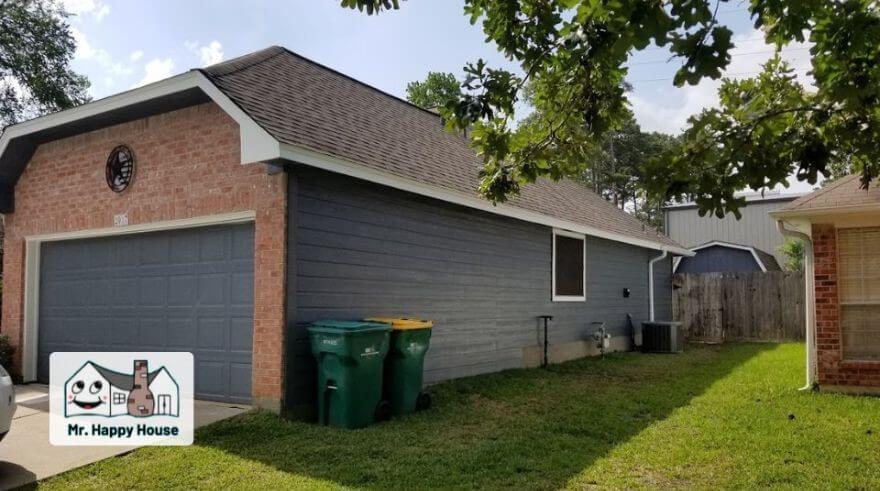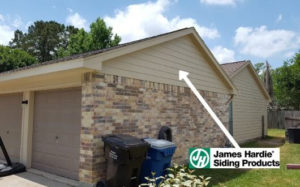
Best GAF Certified Roofers in The Woodlands, TX – Quality Roof Replacement, Gutters & Siding
Best GAF Certified Roofers in The Woodlands, TX – Quality Roof Replacement, Gutters & Siding Best GAF Certified Roofers in The Woodlands, TX – Quality

When it comes to giving your home a fresh, vibrant look, few things can match the transformative power of a fresh coat of paint. Whether you’re aiming to enhance your property’s curb appeal, protect it from the elements, or simply update its appearance, exterior house painting is a significant undertaking that requires careful planning.
One of the key questions that often arises in this process is: When is the best time for exterior house painting? The answer to this question is not one-size-fits-all, as it depends on a variety of factors, including the climate in your region, the type of paint you’re using, and your personal preferences.
In this article, we’ll delve into the considerations that can help you determine the optimal time to embark on your exterior painting project, ensuring that your efforts result in a stunning and long-lasting exterior finish.
Temperature Range: The temperature range is a crucial consideration. Extreme heat or cold can affect the quality and drying time of paint. It’s generally recommended to paint when temperatures are moderate, ideally between 50°F and 85°F. This ensures that the paint adheres well and dries evenly, however if you’re a homeowner in the Houston area, temperatures can stay above 90°F throughout the year, with this in mind, the painting process must be carefully done quickly and efficiently to accommodate the high heat levels.
Rain and Moisture: Painting during rainy conditions is not advisable. Moisture can interfere with the paint’s adhesion and cause it to peel or bubble. Ensure there is no rain in the forecast for at least 24-48 hours after painting to allow the paint to cure properly.
Wind Conditions: Wind can affect the application of paint, causing it to dry too quickly or blow debris onto the freshly painted surface. Choose a day with calm or mild wind conditions to achieve a smooth finish.
Seasonal Considerations: Different seasons offer varying weather conditions. Spring and fall are often considered the best seasons for exterior painting in many regions. Spring provides milder temperatures and less humidity after the winter thaw, while fall offers stable conditions before the onset of winter.
The choice of paint and its finish (sheen) can significantly impact when it’s best to paint your home’s exterior. Here’s how:
Latex Paint: Latex paints are more versatile and can be applied in a broader range of temperatures and humidity levels. They are often preferred for exterior painting because they dry faster and emit fewer fumes. Latex paints are suitable for painting in both spring and fall when temperatures are moderate.
Oil-Based Paint: Oil-based paints require warmer and drier conditions for proper drying and curing. They are less forgiving in extreme cold or humid environments. If you plan to use oil-based paint, consider painting during the warmer months, preferably in late spring or early fall.
Primer and Undercoats: The type of primer and undercoats you use should align with your choice of paint. Ensure they are compatible with the paint type and follow the manufacturer’s recommendations for application conditions.
Finish (Sheen): The finish or sheen of the paint can impact its appearance and durability.
Gloss Finish: Glossy paints are more durable and easier to clean but can highlight imperfections. They are suitable for areas prone to moisture exposure, such as trim and doors. Painting with a gloss finish is best during mild weather to avoid rapid drying.
Satin or Eggshell Finish: Satin and eggshell finishes strike a balance between durability and appearance. They work well for siding and exterior walls and can be applied in moderate weather conditions.
Flat Finish: Flat or matte finishes are less durable but can hide imperfections. They are suitable for low-traffic areas but may require more frequent touch-ups. Flat paints can be applied in a broader range of weather conditions.
Drying Time: Different paint types and finishes have varying drying times. Consider the drying time specified on the paint can and choose a time when you can allow the paint to dry and cure undisturbed. Avoid painting before rain or when heavy dew is expected, as this can affect drying.
The quality and thoroughness of preparation and repairs are crucial factors that influence when it’s best to undertake an exterior house painting project. Here are key considerations:
Surface Cleaning and Sanding:
Timing Consideration: Surface cleaning and sanding should be conducted during periods of dry weather. Avoid painting immediately after heavy rain, as the surface needs to be completely dry.
Importance: Cleaning and sanding ensure a smooth and clean surface for paint adhesion. Remove dirt, mildew, and loose or peeling paint, as these can hinder the new paint from adhering properly.
Repairing Cracks, Holes, and Damage:
Timing Consideration: Make repairs during seasons with mild and stable weather conditions. Avoid rainy or excessively humid periods, as it can affect the quality of repairs.
Importance: Proper exterior home repairs are essential to address structural issues and cosmetic imperfections. Filling cracks and holes, fixing damaged siding, and replacing rotted wood are vital steps to ensure a lasting paint job.
Caulking and Sealing:
Timing Consideration: Apply caulk on days with moderate temperatures and dry conditions. Avoid extremely hot or cold weather that may affect caulk performance.
Importance: Caulking and sealing gaps and seams help prevent moisture infiltration, drafts, and insect intrusion. It also provides a smooth surface for paint application.
Priming:
Timing Consideration: Follow the manufacturer’s guidelines for primer application. Generally, primer should be applied when weather conditions are suitable for the type of paint you plan to use.
Importance: Primer enhances paint adhesion, improves color uniformity, and helps seal porous surfaces. It’s particularly important for bare wood, new surfaces, or when transitioning between paint types.
Drying Time:
Timing Consideration: Allow sufficient drying time for preparation and repair work before applying paint. Drying times may vary depending on the specific products used and weather conditions.
Importance: Proper drying ensures that repairs, cleaning, and priming are fully completed before the paint is applied. Rushing this step can lead to paint adhesion problems.
Weather Forecast:
Timing Consideration: Monitor weather forecasts closely when planning preparation and repair tasks. Be prepared to reschedule if adverse weather conditions are expected, as rain, extreme temperatures, or high humidity can negatively impact the quality of your work.
Importance: Adverse weather can compromise the effectiveness of your repairs and cleaning efforts, leading to paint failure and the need for costly touch-ups.
Timing Convenience: One of the primary considerations when deciding the best time for exterior house painting is your personal schedule and availability. The key is to choose a time when you can dedicate sufficient hours or days to the project without feeling rushed or stressed.
Painting the exterior of your home is a significant undertaking, and having the flexibility to work at your own pace can lead to a more satisfying and successful outcome. Ensure that you plan the painting project during a period when you have the time and energy to invest in it.
Weekends and Holidays: Many homeowners find it convenient to tackle exterior house painting during weekends or holidays when they typically have extended time off from work or other commitments. These periods offer an excellent opportunity to focus on the project without the constraints of a regular workweek.
Planning your painting project for weekends or holidays can provide you with uninterrupted time to prepare surfaces, apply paint coats, and complete the project efficiently. This extended timeframe is particularly advantageous if you intend to manage the project as a do-it-yourself (DIY) endeavor.
Budget Constraints: A crucial aspect of planning your exterior house painting project is assessing your budget and financial availability. Painting the exterior of your home can be a substantial expense, encompassing the cost of paint, supplies, equipment, and, potentially, professional labor.
It’s essential to budget carefully and ensure you have the necessary funds to cover all aspects of the project adequately. Beyond the basic expenses, consider setting aside funds for unforeseen costs or contingencies to prevent financial strain and disruptions during the painting process.
Seasonal Considerations: Seasonal preferences can influence your choice of when to paint your home’s exterior. Some individuals may favor the mild temperatures and pleasant weather conditions of spring or fall, while others might relish the warmth and extended daylight hours of summer.
Your personal comfort and enjoyment during the painting process can be greatly enhanced by selecting a season that aligns with your weather preferences. However, while choosing a season that suits your comfort is important, it’s also vital to factor in weather conditions conducive to successful painting and the need to coordinate your schedule accordingly.
Professional Help: If you plan to hire professional painters for your exterior house painting project, it’s essential to consider their availability and schedule. Professional painters often have busy calendars, particularly during peak painting seasons.
To ensure you can secure their services at your preferred time, it’s advisable to book their services well in advance. By coordinating your schedule with the availability of experienced professionals, you can benefit from their expertise and ensure a smoother, more efficient painting process.
Family Considerations: When planning your exterior house painting project, it’s essential to take into account the needs and schedules of your family members or pets. Disruptions to daily routines and comfort can be minimized by considering their requirements during the project.
Ensuring the safety and well-being of your family and pets while painting is a top priority, so plan accordingly. By making arrangements that accommodate your loved ones, you can maintain a harmonious home environment throughout the painting process.
Successfully painting the exterior of your house involves more than just choosing the right time; it also entails adhering to best practices to ensure a long-lasting and visually pleasing finish. Here are some essential tips:
Proper Preparation: Thoroughly prepare the surfaces before applying paint. This includes cleaning, sanding, repairing any damage, and caulking gaps and seams. Adequate preparation ensures that the paint adheres well and provides a smooth finish.
Quality Materials: Invest in high-quality paint, primers, and materials. Quality products can contribute to a better-looking and more durable result. Consult with experts or follow manufacturer recommendations for product selection.
Surface Dryness: Ensure that the surfaces are entirely dry before painting. Avoid painting on damp or wet surfaces, as this can lead to poor adhesion and paint failure.
Weather Forecast: Continuously monitor the weather forecast during the project. Painting in stable weather conditions is essential to prevent issues like paint blistering, peeling, or not curing properly.
Proper Equipment: Use the right tools and equipment for the job, including brushes, rollers, and sprayers. High-quality equipment can make the painting process smoother and more efficient.
Safety Precautions: Prioritize safety during the project. Use appropriate safety gear, such as goggles, gloves, and masks, and follow safety guidelines when working at heights or with ladders.
Paint Application: Apply paint using the correct techniques and in the right order. Typically, start from the top and work your way down, and follow the recommended number of paint coats.
Drying Time: Allow ample drying time between coats as specified by the paint manufacturer. Rushing this step can result in subpar paint adhesion and finish.
Trim and Detail Work: Pay attention to trim, corners, and other detailed areas. Properly painting these sections contributes to a polished overall appearance.
Cleanup and Disposal: Dispose of paint and painting materials responsibly, following local regulations. Clean up the work area promptly to avoid any accidental damage or staining.
Regular Maintenance: After completing the painting project, establish a regular maintenance schedule. This includes inspecting the paint finish, addressing touch-ups as needed, and ensuring the long-term beauty and protection of your home’s exterior.
Professional Help: If you’re uncertain about any aspect of the project or have concerns about your ability to execute it successfully, consider hiring professional house painters. Experienced professionals can provide expertise, efficiency, and high-quality results.
In conclusion, the optimal time for exterior house painting is a multifaceted decision influenced by a combination of factors, including climate and weather conditions, the type of paint and finish chosen, thorough preparation and repairs, personal schedule and availability, and adherence to best practices for a successful project.
By carefully considering these elements and aligning them with your preferences and circumstances, you can ensure a lasting and visually pleasing finish that enhances your home’s curb appeal and protection. Whether you choose the temperate seasons of spring and fall or the warmth of summer, proper planning and execution will lead to a successful exterior house painting project that beautifies and preserves your home.
We hoped you loved this article on the most popular house paint colors in Texas, please share and tune in for more and house painting content!
Our Services:













Best GAF Certified Roofers in The Woodlands, TX – Quality Roof Replacement, Gutters & Siding
Best GAF Certified Roofers in The Woodlands, TX – Quality Roof Replacement, Gutters & Siding Best GAF Certified Roofers in The Woodlands, TX – Quality

Are Gutters Part of the Roofing System?
Are Gutters Part of the Roofing System? Are Gutters Part of the Roofing System? When it comes to home maintenance, gutters often seem like a

Why James Hardie is The Best Option for Home Siding
Why James Hardie is The Best Option for Home Siding Why James Hardie is The Best Option for Home Siding James Hardie stands out whether











